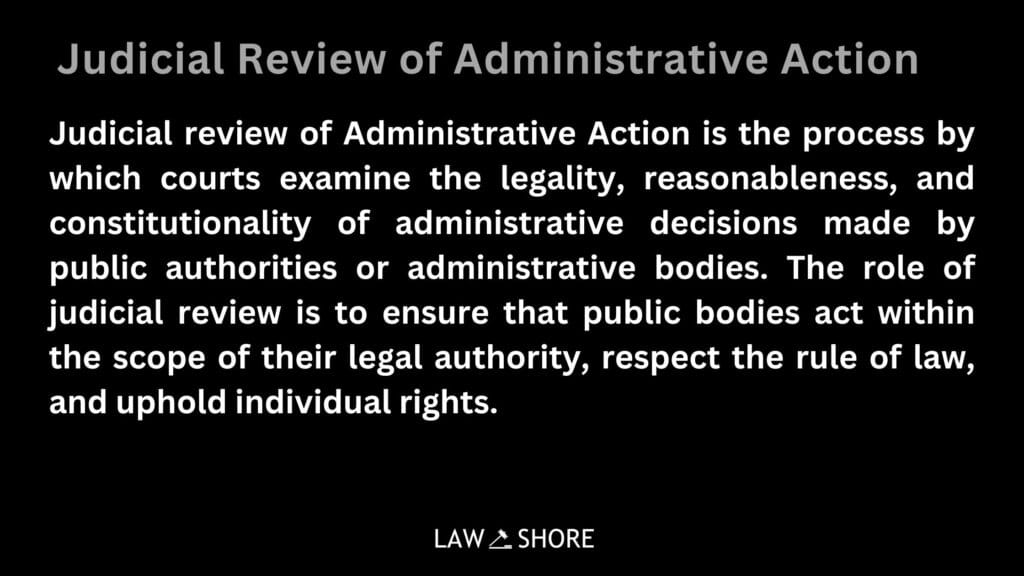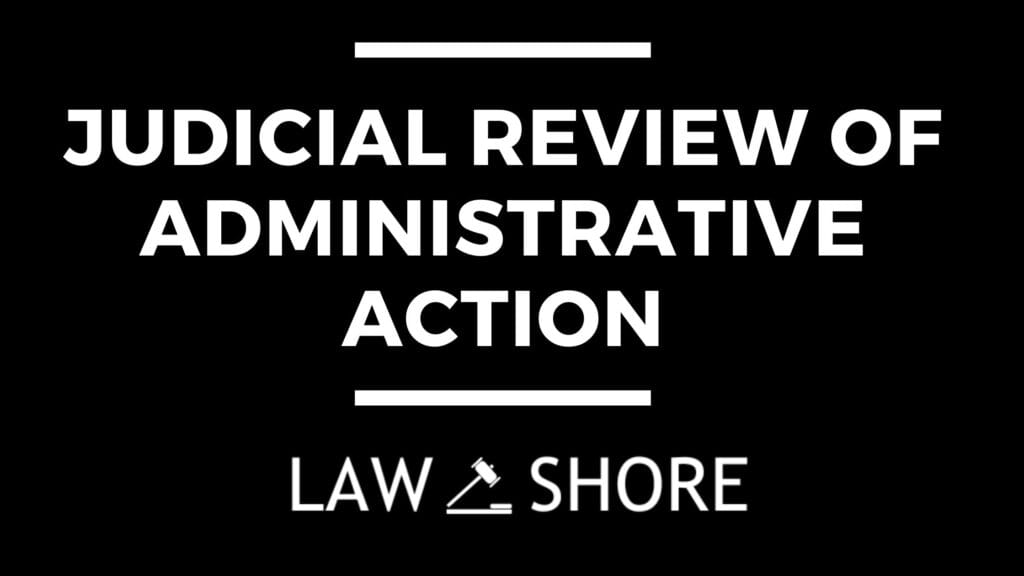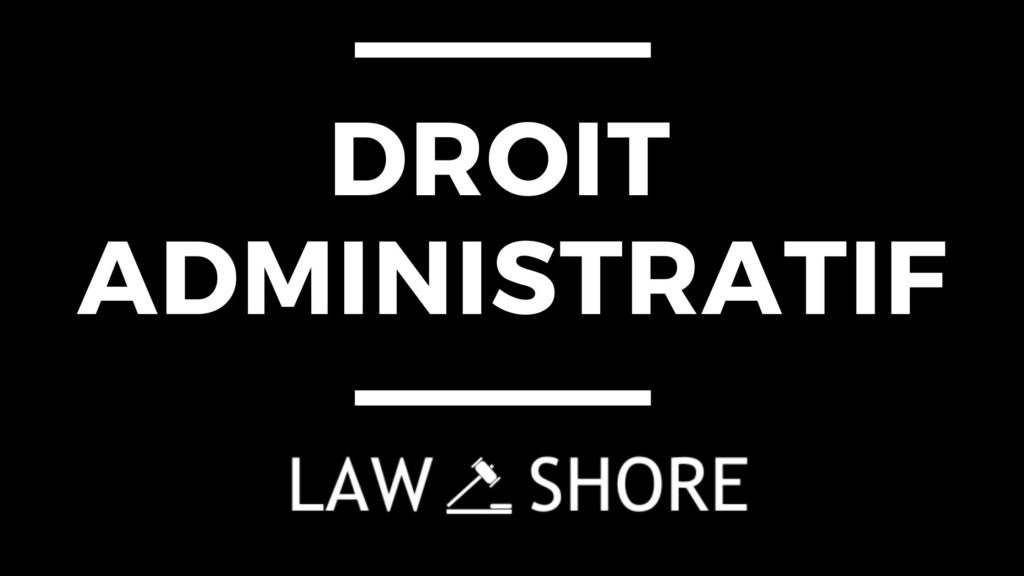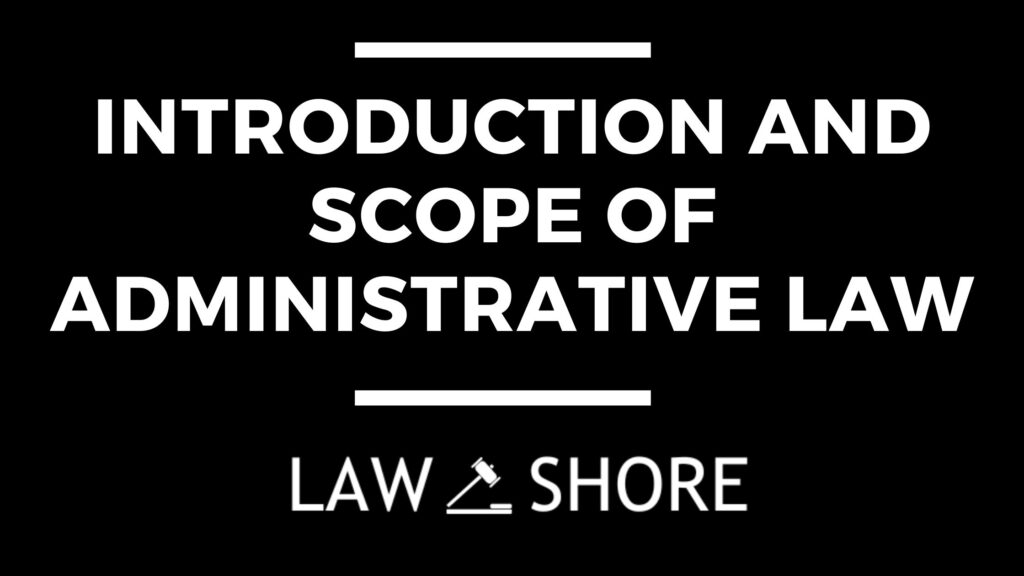Judicial Review of Administrative Action
Table of Contents
ToggleJudicial review of Administrative Action is the process by which courts examine the legality, reasonableness, and constitutionality of administrative decisions made by public authorities or administrative bodies. The role of judicial review is to ensure that public bodies act within the scope of their legal authority, respect the rule of law, and uphold individual rights.
This article explores the key principles, grounds, and procedural aspects of judicial review of administrative action, drawing upon relevant case law and statutory provisions.

What is Judicial Review of Administrative Action?
Judicial review is a mechanism that allows courts to review the decisions or actions of public authorities, including government departments, regulatory bodies, and local authorities, to ensure that they conform to the law. It is a form of legal control over executive action, ensuring accountability and adherence to legal norms.
The scope of judicial review of Administrative Action extends beyond reviewing the correctness of decisions. Instead, it focuses on the legality of the decision-making process, ensuring that public bodies have not exceeded their powers, violated statutory provisions, or acted irrationally.
Purpose of Judicial Review of Administrative Action
The primary purpose of judicial review is to safeguard the rule of law by ensuring that administrative decisions are made within the limits of legal authority and that the administrative process is fair, transparent, and accountable. Judicial review of Administrative Action seeks to prevent unlawful actions, provide remedies for those wronged by administrative decisions, and ensure that public bodies act rationally and in accordance with the law.
- Ensuring Accountability of Public Authorities: Judicial review holds government bodies and public authorities accountable for their actions. By scrutinizing the legality and propriety of decisions made by these bodies, courts ensure that public authorities do not act arbitrarily or abuse their power.
- Protection of Individual Rights: Judicial review helps protect individual rights and liberties from unlawful or unjust administrative actions. It ensures that administrative bodies respect the principles of natural justice, such as the right to a fair hearing and the right to be treated impartially.
- Preventing Abuse of Power (Rule of Law): One of the central goals of judicial review is to prevent abuses of power by administrative bodies. Courts ensure that government decisions are made within the powers granted by law (i.e., within the limits of “jurisdiction”) and that those decisions are reasonable and proportionate to the objective pursued.
- Ensuring Legality and Consistency in Decision-Making: Judicial review provides consistency and predictability in administrative decision-making by ensuring that decisions are made in accordance with existing laws, statutes, and legal principles. Courts assess whether decisions are based on legal standards and whether relevant laws are properly applied.
- Promoting Fairness in Administrative Processes: Judicial review promotes procedural fairness by ensuring that decisions are made following proper procedures and giving affected individuals or parties the opportunity to be heard. It checks whether administrative bodies have followed procedural requirements, such as proper notice, hearings, or impartiality.
Judicial review performs two functions:
- Legitimises the government action, and
- Protect the Constitution against any undue encroachment by the Government.
Grounds for Judicial Review of Administrative Actions
The following are the four major grounds for judicial review of Administrative Action in India:
- Illegality (acting beyond authority or misinterpreting the law)
- Irrationality (unreasonable or arbitrary decision)
- Procedural fairness (failure to follow correct procedures)
- Proportionality (excessive or insufficient response to the objective pursued)
Illegality (Acting Beyond Authority or Misinterpreting the Law)
Illegality is the primary ground for judicial review. If an administrative body or public authority acts beyond its legal powers or misinterprets the law, its decision can be challenged. Courts will review whether the authority has acted within the jurisdiction granted to it by statute or the Constitution.
Key Aspects of Illegality:
- Ultra Vires: If a decision is made beyond the powers conferred by law, it is termed as ultra vires (literally “beyond the powers”). Administrative bodies must operate within the legal boundaries set by the legislature.
- Misinterpretation of Law: If an authority misconstrues or misapplies a legal provision or acts in a manner inconsistent with legislative intent, the decision can be challenged on the ground of illegality.
Irrationality (Unreasonable or Arbitrary Decision)
Irrationality refers to a decision that is so unreasonable, illogical, or arbitrary that no reasonable person or body could have come to the same conclusion. This ground is often referred to as the Wednesbury Unreasonableness test, which states that a decision is irrational if it is so extreme or disproportionate that no reasonable authority could have made it.
Key Aspects of Irrationality:
- Unreasonableness: A decision is considered irrational if the decision-maker fails to consider relevant factors or makes a decision that is disproportionate to the facts at hand.
- Arbitrariness: A decision is arbitrary if it lacks a rational basis, especially when it is based on whim, bias, or prejudice rather than reasoned judgment.
Procedural Fairness (Failure to Follow Correct Procedures)
Procedural fairness, also known as natural justice, ensures that decisions affecting individuals are made in a fair and transparent manner. Judicial review on the ground of procedural fairness examines whether the procedure followed by the administrative body was just, equitable, and in accordance with legal requirements.
Key Aspects of Procedural Fairness:
- Right to a Fair Hearing: This principle, also called audi alteram partem, requires that an individual be given a fair opportunity to present their case before any decision that affects them is made.
- Rule Against Bias: The decision-maker must be impartial. The principle of nemo judex in causa sua ensures that no person should judge a case in which they have an interest or bias.
- Right to be Informed: The person affected by a decision should be informed of the reasons for the decision and the evidence relied upon, enabling them to respond appropriately.
Proportionality (Excessive or Insufficient Response to the Objective Pursued)
The proportionality principle holds that the measures taken by public authorities should be appropriate and necessary to achieve the desired objective. A decision or action can be challenged if it is disproportionate—either too excessive or insufficient—relative to the aim it seeks to achieve.
Key Aspects of Proportionality:
- Appropriateness: The action or decision must be appropriate to achieve the objective. A measure that is not suitable for the purpose cannot be justified.
- Necessity: The action must be necessary, meaning that less intrusive or restrictive alternatives have been considered and rejected.
- Balance: The harm caused by the action must not outweigh the benefits it seeks to achieve. An action that causes excessive harm compared to its benefit is disproportionate.
Summary of Grounds for Judicial Review of Administrative Action in India
Ground | Description | Key Principle |
|---|---|---|
Illegality | Decision made beyond legal authority or misinterpretation of law | Ultra vires |
Irrationality | Decision is unreasonable, arbitrary, or extreme | Wednesbury unreasonableness |
Procedural Fairness | Failure to follow fair and just procedures | Audi alteram partem (Right to fair hearing) & Nemo judex in causa sua (No bias) |
Proportionality | Action is disproportionate in relation to the objective pursued | Appropriateness, necessity, and balance |
Difference Between Judicial Review and Appeal
Judicial review and appeals are both mechanisms by which a higher court reviews decisions made by a lower authority or body. However, they serve different purposes, operate under different principles, and have distinct procedural characteristics. Below is a detailed comparison between the two:
Aspect | Judicial Review | Appeal |
|---|---|---|
Purpose | To examine the legality, reasonableness, and fairness of a decision made by an administrative body or lower court. It focuses on ensuring that public bodies and authorities act within their legal powers. | To reassess the merits of a decision made by a lower court or administrative body, typically on the grounds of an error in law, fact, or procedure. |
Focus | Legality and procedural propriety of the decision-making process. | Substantive correctness of the decision, including its findings of fact and law. |
Grounds for Review | Illegality (acting beyond authority or misinterpreting the law) Irrationality (unreasonable or arbitrary decision) Procedural fairness (failure to follow correct procedures) Proportionality (excessive or insufficient response to the objective pursued) | Error of law (incorrect application of law) Error of fact (incorrect understanding or evaluation of facts) Error of procedure (incorrect procedural steps taken in the initial decision) |
Scope of Review | Limited to the legality of the decision or the decision-making process itself. The court will not review the merits (substance) of the decision. | The court reviews the merits of the case, which includes both factual and legal aspects of the decision. |
Role of Court | The court acts as a supervisory body to ensure that administrative bodies or lower courts act within the bounds of the law. The court does not substitute its own judgment. | The court re-evaluates the substance of the case and may replace or modify the lower court’s decision if it finds errors in law or fact. |
Nature of the Decision | A decision may be quashed (invalidated), amended, or declared unlawful. | A decision may be upheld, modified, or overturned based on the assessment of the facts and law. |
Outcome | If judicial review is successful, the decision is often annulled, or the body is required to reconsider the matter following proper procedures. | If an appeal is successful, the appellate court may alter the decision (e.g., reduce sentence, award damages) or remand the case for further consideration. |
Remedies | – Quashing order (certiorari): To cancel or nullify an unlawful decision. – Prohibiting order: To prevent a body from acting in an unlawful way. – Mandatory order (mandamus): To compel an authority to act lawfully. | – Modification or overturning of the decision based on the appeal’s merits. – New hearing or retrial: In some cases, the case may be sent back to the lower court or tribunal for a new trial. |
Flexibility | More limited in scope and less flexible in terms of examining the actual decision or factual evidence. | More flexible, as it allows for a detailed review of facts, law, and judicial reasoning. |
Power of Judicial Review of the Supreme Court and High Courts in India
Judicial review of Administrative Action refers to the power of courts to examine the constitutionality and legality of legislative, executive, and administrative actions. In India, judicial review is a fundamental aspect of the judicial system, primarily vested in the Supreme Court and High Courts. This power ensures that the government acts within its constitutional limits and that fundamental rights of citizens are protected.
India’s constitutional framework, through Articles 32, 136, 226, and 227, empowers the Supreme Court and High Courts to engage in judicial review, thus safeguarding the Rule of Law, the separation of powers, and the rights of the individuals.
Judicial Review by the Supreme Court
Article 32 of the Indian Constitution, often called the “Soul of the Constitution,” provides citizens with the right to approach the Supreme Court for the enforcement of their Fundamental Rights. The Supreme Court’s power to review and protect these rights plays a pivotal role in maintaining constitutional supremacy and preventing any unconstitutional acts by the state.
1. Scope of Judicial Review under Article 32
Article 32 guarantees the right to move the Supreme Court directly for the enforcement of Fundamental Rights. The power of judicial review under this article is expansive, allowing the Court to assess whether any law, executive action, or government policy is inconsistent with the Constitution, particularly the Fundamental Rights enumerated in Part III of the Constitution.
Enforcement of Fundamental Rights
- Writ Jurisdiction: Under Article 32, the Supreme Court can issue various writs like Habeas Corpus, Mandamus, Prohibition, Certiorari, and Quo Warranto to ensure the enforcement of Fundamental Rights.
- Judicial Review of Legislation and Executive Action: The Supreme Court can scrutinize laws and executive orders to determine if they violate any of the Fundamental Rights or the basic structure of the Constitution.
2. Article 136: Special Leave to Appeal by the Supreme Court
While Article 136 does not directly confer judicial review powers on High Courts, it allows the Supreme Court to grant special leave to appeal against decisions made by the High Courts, even if there is no constitutional issue involved. This serves as an additional layer of judicial review over High Court decisions.
- Scope of Article 136: The Supreme Court has the discretion to grant special leave to appeal, thus providing a mechanism for review of High Court judgments that may have erred in applying the law or principles of justice.
Judicial Review by High Courts
The High Courts, under various provisions of the Constitution, also have significant judicial review powers. These powers are essential in maintaining the rule of law and ensuring that laws, administrative actions, and executive orders comply with the Constitution.
1. Article 226: Power of High Courts to Issue Writs
Article 226 gives High Courts the power to issue writs for the enforcement of Fundamental Rights and other legal rights. This provision empowers High Courts to act as a check on the legality of executive actions within their jurisdiction.
2. Scope of Judicial Review under Article 226
High Courts have the authority to issue writs like Habeas Corpus, Mandamus, Prohibition, Certiorari, and Quo Warranto not only for the enforcement of Fundamental Rights but also for ensuring that other legal rights are not violated.
- Power over all authorities: Unlike the Supreme Court, which can only issue writs for the enforcement of Fundamental Rights, High Courts can issue writs for any other legal right as well. This means High Courts are empowered to review laws, orders, and actions of both the central and state governments, and even public authorities, if they violate legal rights.
3. Article 227: Power of High Courts to Supervise Lower Courts and Tribunals
Article 227 empowers High Courts to exercise supervisory jurisdiction over all subordinate courts and tribunals in their respective states. This allows High Courts to ensure that lower courts and tribunals act within their jurisdiction and follow the law correctly.
- Scope of Supervision: High Courts can issue directions to lower courts to prevent the violation of legal procedures and rectify any errors of law or jurisdiction.
- Judicial Review of Administrative Decisions: Under Article 227, High Courts can review administrative actions and ensure they are in conformity with the law. This includes reviewing the correctness of decisions made by tribunals or quasi-judicial bodies that fall under the supervision of the High Court.
Remedies for Judicial Review of Administrative Actions
The remedies for judicial review of administrative actions are generally five types of writs under Article 32 (Supreme Court) and Article 226 (High Courts) of the Indian Constitution. The five writs that can be issued for judicial review are:
Habeas Corpus
- Meaning: “You shall have the body.”
- Purpose: This writ is issued to secure the release of a person who is illegally detained or imprisoned. It can be filed by the person or by someone on their behalf. The court orders the authority who is holding the person to bring the person before the court and justify the legality of the detention.
- Example: If someone is detained without trial or without proper legal justification, they can seek the writ of Habeas Corpus to challenge their detention.
Mandamus
- Meaning: “We command.”
- Purpose: This writ is issued by a higher court (Supreme Court or High Court) to a public authority, commanding it to perform a public duty that it has failed to perform. It can be issued to compel a government official or body to do something they are legally obligated to do.
- Scope: Mandamus can be issued to any public authority, not private individuals.
- Example: If a government agency is failing to issue a license or permit as required by law, a writ of Mandamus can be filed to compel them to do so.
Prohibition
- Meaning: “To forbid or prevent.”
- Purpose: This writ is issued by a higher court to prevent a lower court or tribunal from exceeding its jurisdiction or acting beyond its authority. It essentially prohibits the lower court from continuing proceedings in a matter that it has no jurisdiction over.
- Scope: It is used to ensure that a lower court or tribunal does not violate the limits of its jurisdiction.
Certiorari
- Meaning: “To be certified or to be informed.”
- Purpose: This writ is issued by a higher court to a lower court or tribunal to quash an order or decision that is found to be illegal, unconstitutional, or in excess of jurisdiction. It is used to review the decisions of inferior courts or tribunals.
- Scope: It helps in preventing any miscarriage of justice by quashing decisions that violate legal principles.
Quo Warranto
- Meaning: “By what authority or warrant.”
- Purpose: This writ is issued to a person who is holding a public office without a valid legal authority. It questions the legality of a person’s claim to a public office and seeks to remove them if they are occupying it without proper authorization or election.
- Scope: This writ ensures that only legally entitled individuals hold public offices.
- Example: If someone is appointed to a public position without the required qualifications or election process, a writ of Quo Warranto can be filed to challenge their appointment and remove them from the office.
Relevant Case Laws Related to Judicial Review of Administrative Action
Below are some key Indian case laws that have shaped judicial review in administrative law:
Kesavananda Bharati v. State of Kerala (1973)
- Principle: Basic Structure Doctrine
- Summary: In this landmark case, the Supreme Court ruled that while Parliament has wide powers to amend the Constitution, it cannot alter the basic structure of the Constitution. The case established that judicial review is an integral part of the Constitution and that the basic structure doctrine must be protected. This judgment underlined the importance of judicial review in maintaining constitutional supremacy and preventing arbitrary exercises of power.
- Relevance to Judicial Review: This case reaffirmed that judicial review is a fundamental aspect of the Constitution, ensuring that no law, including constitutional amendments, can violate the basic structure of the Constitution.
State of West Bengal v. Nripendra Nath (1976)
- Principle: Illegality (Ultra Vires)
- Summary: This case dealt with the concept of ultra vires or actions taken beyond the power conferred by law. The Supreme Court held that if a statutory authority acts beyond the powers conferred by statute, its actions are ultra vires and therefore void. The Court stated that the power of judicial review extends to ensuring that the exercise of power is within the statutory limits.
- Relevance to Judicial Review: This case is an important affirmation of the illegality ground for judicial review, particularly in cases where a public authority exceeds the powers given to it by statute or law.
L. Chandra Kumar v. Union of India (1997)
- Principle: Judicial Review of Tribunals
- Summary: The Supreme Court ruled that the High Courts under Article 226 and the Supreme Court under Article 32 have the power of judicial review over the actions of tribunals and administrative bodies. The Court held that the power of judicial review is an essential feature of the Constitution and cannot be ousted, even by a constitutional amendment.
- Relevance to Judicial Review: This case is significant as it establishes that judicial review is a basic structure of the Constitution, and courts have the authority to review not only legislative and executive actions but also decisions made by tribunals or quasi-judicial bodies.
Tata Cellular v. Union of India (1994)
- Principle: Judicial Review of Administrative Decisions
- Summary: The case involved a tendering process for the mobile phone network, where the Supreme Court emphasized the limited scope of judicial review of administrative decisions. The Court held that while judicial review is available, it cannot interfere with decisions unless they are illegal, arbitrary, or irrational. It highlighted the principle that courts should not act as appellate authorities over administrative decisions but can intervene in cases of illegality, irrationality, or procedural irregularity.
- Relevance to Judicial Review: This case is important for its clarification of the scope of judicial review over administrative decisions, highlighting that judicial review is not an appeal but a safeguard against arbitrariness and illegality in decision-making.
Conclusion
Judicial review is a cornerstone of administrative law, ensuring that public authorities act within the law, respect individual rights, and operate transparently. The key principles of judicial review—illegality, irrationality, procedural impropriety, and proportionality—serve to safeguard the rule of law and prevent abuse of power. Judicial review remains an essential tool for ensuring that administrative decisions are lawful, fair, and reasonable.
The principles discussed, supported by case law, reveal the evolving nature of judicial review, particularly in the context of human rights and the growing recognition of proportionality as a central element in common law jurisdictions.
Also, Check Out Other Topics in Administrative Law:
- Introduction and Scope of Administrative Law
- Droit Administratif
- Ombudsman in Administrative Law
- Promissory Estoppel in Administrative Law
- Public Corporation in Administrative Law
- Reasons for Growth of Administrative Law
- Separation of Powers in Administrative Law
- Doctrine of Ultra Vires in Administrative Law
- Whistleblowing
- Nature of Administrative Law
- Red Light and Green Light Theory of Administrative Law
- Sub Delegation in Administrative Law
- Delegatus Non Potest Delegare
Explore Law Shore: law notes today and take the first step toward mastering the fundamentals of law with ease.

After Completing my LLB hons, I started writing content about legal concepts and case laws while practicing. I finally started Law Shore in 2024 with an aim to help other students and lawyers.



